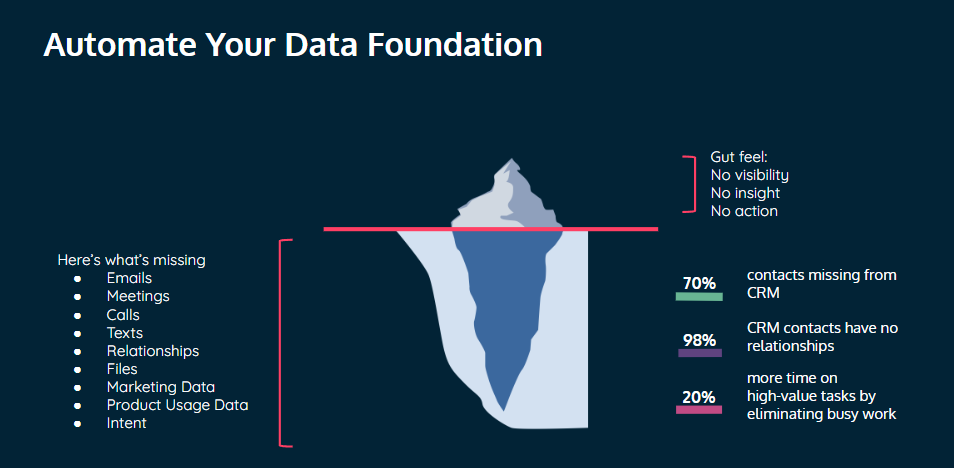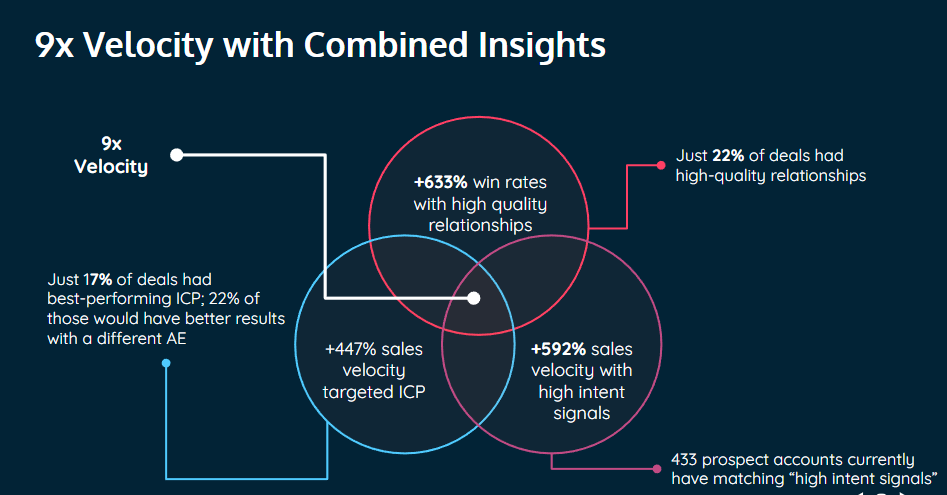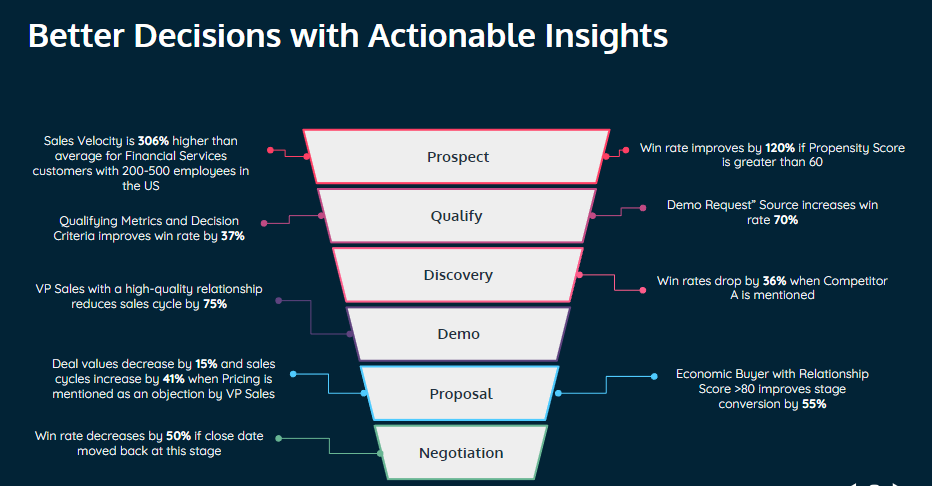This week we brought together Guy Rubin, Founder & CEO of Ebsta, and Alex Irschenberger, VP of Strategy & Growth at Contractbook together with our Founder & Chief Strategist, Paul Sullivan, for a HubSpot User Group (HUG) on how to future-proof your sales team and strategy for 2024 and beyond.
We kicked off with Guy, who presented the findings of Ebsta’s recent B2B Sales Benchmark Report, which analysed over 3 million opportunities, representing a staggering $37 billion worth of pipeline.
He started by touching upon the challenges faced by businesses in 2022 (average deal values were much lower and sales cycles were much longer) and some positive turnaround observed in 2023, including increases in win rates, slightly better (albeit still long) sales cycles and a boost in average deal values.
The persistence of sales operations inefficiencies
Despite these positive signals, Guy outlined that inefficiencies in sales operations persist. The number of reps that missed quota actually slightly increased in 2023. Perhaps a part of that is down to the fact that people's quotas are higher than they were expecting, or that people are expecting more from less, which we know is a growing trend.
But one of the biggest points from the data this year was what Guy described as the velocity delta. This is the gap between the top performing individual contributors in your business and the rest of the Account Executives (AEs). On average, 23% of your reps are now generating 83% of business revenue.
Another data point he described as “slightly shocking” was the percentage of deals that eventually slip from the date predicted to close. Slippage is quantified as deals that have been in process, where you pass the qualification stage and have an anticipated close date. Nearly 40% of the opportunities opened actually slipped past four weeks. "When we see that level of slippage, the win rates drop by nearly 50%,” Guy stated.
Boston Consulting Group made a statement recently that there's a $2 trillion inefficiency within B2B sales - and Ebsta saw this mirrored in the data. Close lost deals spend almost twice as long in pipe than closed won deals, which means your team is spending twice as much time and effort on deals most likely not going to close.
Building a predictable revenue model
Guy outlined three major milestones that you should be thinking about when you want to start to build this predictable approach to scaling your revenue - data, insights and process.
Data
Confidence in the data is critical. So many organisations continue to rely on sales people to manually log their activity, create contacts in CRM and to keep those contacts up to date when someone changes their job title or their telephone number. Bottom line: there’s no reason this shouldn’t be automated by now.

Credit: Ebsta 2023
Takeaway: We shouldn't have to worry about dirty data in 2023 and beyond. Businesses must have an engine that keeps data clean and up to date.
And by doing that, Guy emphasises, you end up in this virtuous circle, because the data is clean, and therefore the reps want to use it. It makes their jobs easier.
You can't be data-driven if you haven't got the data.
Insights
Data is worth nothing unless it gives you insights. Guy outlined six key data points that influence revenue that you should be analysing:
- Ideal customer profile (ICP): Apparently few opportunities in pipe are actually fitting the ICP, a worrying trend.
- Intent data: Given that 5% or less of your targets are in the market at any given time, you need to be utilising this. There’s first party intent data, which is who's coming to your website, who's downloading your content, who's coming to your webinars, etc. And third party data, where providers such as Bombora, RollWorks, etc. provide you with data points to understand who's actually Googling your keywords and in market for your products.
- Personas: If you don’t have them yet, it’s time to create them. Going in through a champion rather than directly to an economic buyer might actually shorten the sales cycle and improve the win rates. Try and understand which personas are giving you the best outcomes, not just at the initial stage, but throughout the sales cycle. At BIAS, we believe you should understand the personas within each account you're targeting, and ensure you're building relationships with all of them.
- Engagement score: Ebsta scores every relationship out of 100, and it's not unusual to see win rates three or four times higher if the engagement is above 80. The longer the sales cycle, the more important the relationships are.
- Deal qualification methodologies: If you're not already using one, you absolutely should. Guy outlined that according to their analysis, it doesn't seem to make a difference which methodology you use (MEDDICC, BANT, etc.), but you do need one to qualify appropriately. We see time and again sales reps with happy ears skipping through the sales opportunities which aren't necessarily real, getting legal and other departments involved for no reason.
- Time. “Time kills all deals. If you’ve got a 30-, 60-day sales cycle and you’re seeing deals go 50% longer, be brave and close it down. We see that 90% of those deals will end up close lost anyway.” If you start to see deals go stale, the chances are you're not actually in a sales process.
Combining these six have an exponential effect: According to the report, there was a 9x increase in sales velocity by doing so. Guy also discussed the importance of understanding the strategies employed by top performers for revenue breakthroughs.

Credit: Ebsta 2023
What the best sellers do differently
Invest in relationships
The best performers are the ones investing in those relationships. Not just high engagement in the relationships involved in the active sales processes, but actually high engagement in the relationships in general in their market. They're the ones going to the events, they're the ones networking in their market, they're building up their network and they're maintaining that relationship.
They live or die by deal methodologies
Top performers are the ones that are religiously using deal methodologies, making sure that they're qualifying the customer – not just in the initial qualification meeting, but every single meeting.
Pace and ICP
The pace at which they run their sales processes means you’re seeing progress almost every week. And finally, having at least 30% of their pipeline as ICP is key. This sounds low, but given that most deals in pipe aren’t ICP-matched, even 30% is a statement.
Process, process, process
When discussing processes and looking at the different stages of the sales cycle, you should be thinking about what signals you're looking for at each stage.
At the top of the funnel, are you targeting companies with high intent or propensity to buy? We know that not all leads are equal. You should be lasering in on the ones that come in through a demo request before someone who just downloaded some content. Or those that you can see are using certain keywords identified as speeding up the process.

Credit: Ebsta 2023
AI’s role in sales
AI-supported calling is critical here. AI can record the call and alert you when key numbers and data points appear that are important for the success of the opportunity. (FYI, this is now available inside HubSpot, which can automatically qualify the opportunity for you).
Data-driven insights are useful not just for the leaders in the business, but also vital for the reps on the ground. They can use it to understand their best next action. For instance, AI is helping them to get to grips what they haven't done yet or where the risk factors are. It helps them target opportunities that look similar to successful closed won deals in the past.
Further up the chain, managers can use the data to do their pipeline inspections. This enables them to keep reps in check and ensure that they're working deals that are real. The knock on effect is that leaders are able to get confidence in the forecast, so that they can invest earlier and help the business scale faster.
All these incremental changes and this consistent approach means that you're able to scale the revenue engine of your business much faster.
A note to marketers: this isn’t about more leads. It’s about small improvements at each stage of the sales cycle, which lead to an exponentially better outcome. This is about understanding all the signals around the business that have influenced revenue in the past and then using it as a benchmark to improve in the future.
Guy gave five takeaways:
- Build a high-quality foundation of relevant data automatically
- Measure your pipeline and sales velocity to drive more effective results
- Identify what factors (e.g. relationships, intent) have the greatest impact
- Score relationships, account propensity and deals to help focus teams
- Deep-dive into funnel to remove friction and amplify high-impact factors
For more insights, check out Ebsta’s full report here, and keep and eye out for part two of the HUG wrap up.



